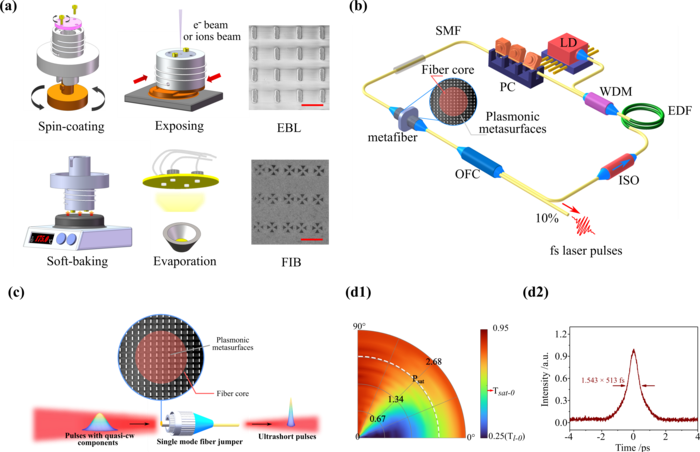Planar waveshaping, super-resolution imaging, and ultracompact sensing are just a few of the advanced uses that can be produced by integrating plasmonic metasurfaces on optical fiber tips, or “metafibers.”

Study: Image Credit: Gorodenkoff/Shutterstock.com
This enhancement of an ordinary optical fiber’s functionalities is made possible by plasmonic metasurfaces. However, the majority of plasmonic metafiber research to date has focused on individual bare fibers, and nonlinear plasmonic regimes have received little attention.
Due to the large aspect ratio of bare fibers, nanofabrication suffers from inevitable mechanical vibrations, which leads to poor repeatability of nanostructures.

a, Nanofabrication of plasmonic metafibers using standard electron-beam lithography (EBL) or focused ions beam milling (FIB) and the corresponding SEM images. b, Home-built ultrafast fibre laser integrating a plasmonic metafiber. c, Schematics of metafibers used as saturable absorbers. d, Nonlinear characterization of metafibers and the corresponding mode-locking performance. (d1) Power- and polarization-dependent nonlinear transmission of a nanorod metasurface in resonant excitation conditions. The polar coordinates (P, θ) represent the averaged power in the focus and the polarization angle of the incident light. (d2) Autocorrelation trace of a single soliton at pump power of 58 mW. Image Credit: Lei Zhang, Huiru Zhang, Ni Tang, Xiren Chen, Fengjiang Liu, Xiaoyu Sun, Hongyan Yu, Xinyu Sun, Qiannan Jia, Boqu Chen, Benoit Cluzel, Philippe Grelu, Aurelien Coillet, Feng Qiu, Lei Ying, Wei E. I. Sha, Xiaofeng Liu, Jianrong Qiu, Ding Zhao, Wei Yan, Duanduan Wu, Xiang Shen, Jiyong Wang, and Min Qiu
In addition, the connections between functionalized bare fibers and standard optical fibers introduce the possibility of contamination, which could even result in damage to the plasmonic metasurfaces. Therefore, it is obvious that techniques for creating metafibers with repeatable metasurface geometry and common adaptable interfaces are required.
Researchers from the Key Laboratory of 3D Micro/Nano Fabrication and Characterization of Zhejiang Province, School of Engineering, Westlake University, China, and colleagues have developed methodologies that incorporate well-defined metasurfaces directly on the end faces of commercial single-mode fiber jumpers (SMFJs), using the standard planar technologies, such as electron-beam lithography (EBL) and focused ions beam (FIB).
The study was published in the journal Light: Advanced Manufacturing.
Because only standard nanofabrication techniques are required, the process flow can be accessed by worldwide cleanrooms.
Min Qiu, Professor, Key Laboratory of 3D Micro/Nano Fabrication and Characterization of Zhejiang Province, School of Engineering, Westlake University
The created metafibers were then incorporated into the fiber laser cavities to function as a unique saturable absorber, which is a crucial component of the general operation of ultrashort laser pulses.
By tuning the plasmonic resonances of the metafibres, we realized all-fiber sub-picosecond soliton mode-locking at different wavelength bands.
Xiang Shen, Professor, Laboratory of Infrared Material and Devices & Key Laboratory of Photoelectric Materials and Devices of Zhejiang Province, Advanced Technology Research Institute, Ningbo University
Along with the experimental study, they also clarified the underlying physical principles of nonlinear optical effects and developed a mathematical method for estimating the saturable absorption of plasmonic metasurfaces.
Such plasmonic metafibers provide new perspectives on ultrathin nonlinear saturable absorbers for applications where tunable nonlinear transfer functions are needed, such as in ultrafast lasers or neuromorphic circuits. The work paves the way towards ‘all-in-fibers’ optical systems for sensing, imaging, communications, and many others.
Dr Jiyong Wang, Key Laboratory of 3D Micro/Nano Fabrication and Characterization of Zhejiang Province, School of Engineering, Westlake University
Journal Reference
Zhang, L., et al. (2022) ‘Plug-and-play’ plasmonic metafibers for ultrafast fibre lasers. Light: Advanced Manufacturing. doi.org/10.37188/lam.2022.045.